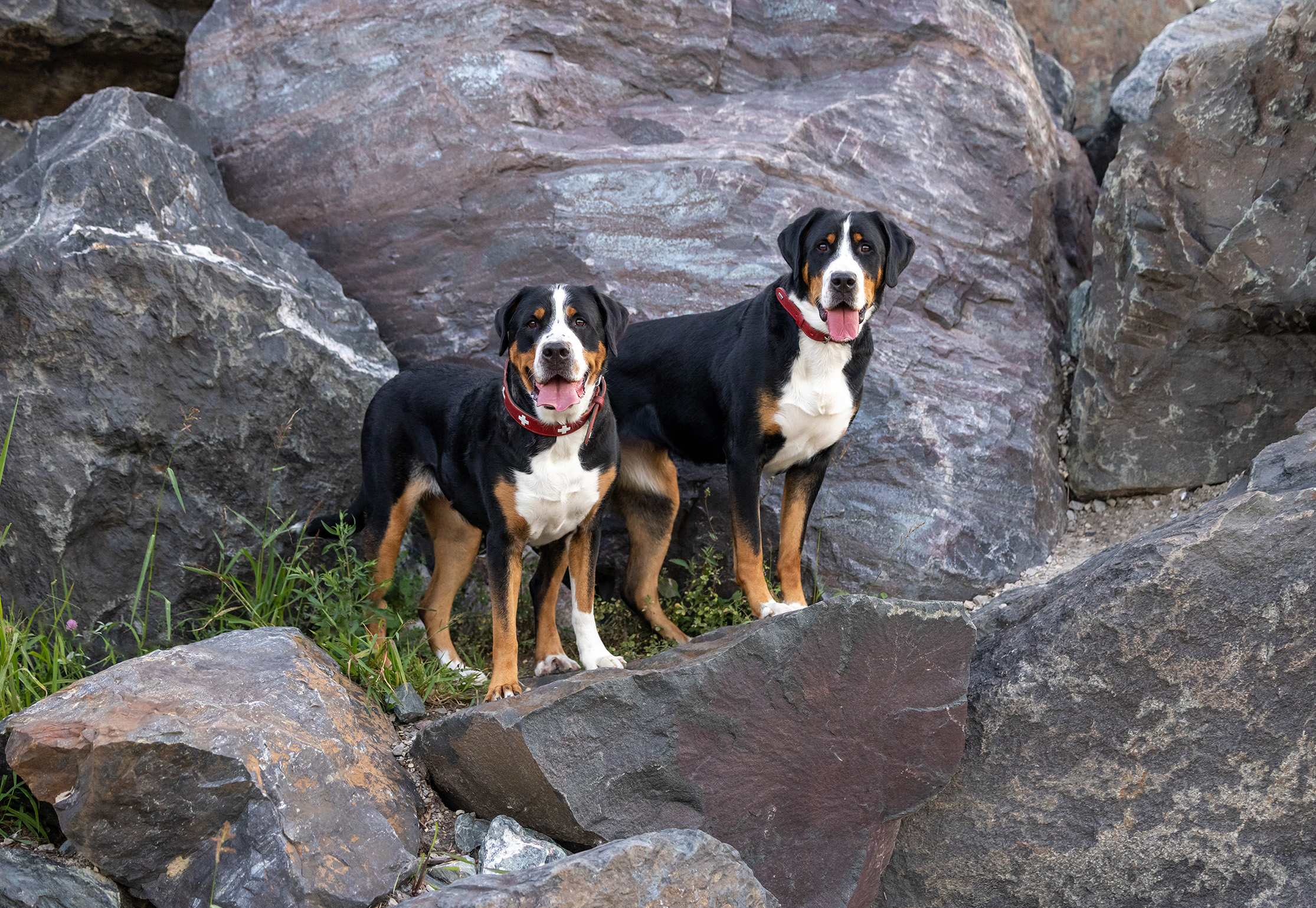Greater Swiss Mountain Dog

Description
The Greater Swiss Mountain Dog (often called the "Swissy") is a large and powerful breed known for its strength, agility, and affectionate nature. Originally from the Swiss Alps, this breed was developed as a working dog for tasks such as herding cattle, pulling carts, and guarding livestock. The Greater Swiss Mountain Dog is one of the oldest Swiss mountain dog breeds, and while it still retains its strong work ethic, it is now more commonly kept as a loyal companion and family dog.
Physically, the Greater Swiss Mountain Dog is an imposing yet well-balanced breed, standing between 23 and 29 inches at the shoulder and weighing between 85 and 140 pounds. It has a large, muscular body with a broad chest, strong limbs, and a powerful build that reflects its heritage as a draft and working dog. The breed’s thick double coat, which is primarily black with tan and white markings, provides protection against the cold weather in its mountainous homeland. The coat is relatively low-maintenance, though regular brushing is necessary to keep it clean and healthy. The Greater Swiss Mountain Dog’s expression is confident and alert, with dark eyes and a square-shaped muzzle that adds to its dignified appearance.
Known for its gentle and affectionate temperament, the Greater Swiss Mountain Dog is often described as a "giant teddy bear." While the breed’s imposing size may initially be intimidating, it is typically very friendly, good-natured, and especially devoted to its family. The Greater Swiss Mountain Dog is known for being patient with children and often gets along well with other dogs and pets when properly socialized. It can be somewhat reserved with strangers but is not aggressive, instead being cautious and protective when needed. As a natural guardian, the breed is watchful and alert, but it is more likely to show loyalty and protectiveness than outright aggression.
Though the Greater Swiss Mountain Dog is generally calm and well-mannered indoors, it is an active and intelligent breed that requires regular exercise to stay healthy. It enjoys outdoor activities like hiking and playing in the yard, and it thrives in homes with space where it can move freely. The breed’s background as a working dog means it enjoys tasks that involve both physical and mental stimulation. While it is a loyal companion that enjoys being with its family, it can also be independent at times and may require patient training, especially if it is not socialized properly early in life. Consistent, positive reinforcement is key to ensuring that the Greater Swiss Mountain Dog learns to follow commands and behaves appropriately.
In conclusion, the Greater Swiss Mountain Dog is a strong, affectionate, and reliable breed that makes an excellent companion for active families or individuals who have the space and time to care for its physical and emotional needs. With its majestic appearance, loyalty, and natural instincts, the Swissy is a versatile dog that excels in many roles—from family companion to working dog. Its friendly, calm demeanor, combined with its protective nature, makes it a great addition to homes where it can be both a devoted protector and loving family member.
History
The Greater Swiss Mountain Dog, often affectionately called the "Swissy," is a large and powerful breed with a history that dates back to ancient times in the Swiss Alps. It is one of the four Swiss mountain dog breeds and is believed to have descended from mastiff-type dogs brought to the region by Roman legions over 2,000 years ago. These robust dogs were likely crossbred with local herding and guard dogs, resulting in a versatile working breed well-suited to the challenging alpine environment.
Historically, the Greater Swiss Mountain Dog was a multipurpose farm dog, valued for its strength, loyalty, and adaptability. It was used to pull carts loaded with milk and other goods, herd livestock, and guard farms. Known as the "poor man’s horse," the Swissy played a critical role in the daily lives of farmers in rural Switzerland. Its distinctive tricolor coat, consisting of black, white, and rust markings, made it a striking yet practical choice for work in the snowy Alps.
By the late 19th century, the breed’s numbers began to decline due to the mechanization of agriculture and the rise of specialized dog breeds. In 1908, the Greater Swiss Mountain Dog was rediscovered by Dr. Albert Heim, a Swiss geologist and dog enthusiast who recognized the breed’s historical significance and worked to preserve it. Thanks to his efforts, the breed was officially recognized by the Swiss Kennel Club in 1910 and later gained international recognition.
Today, the Greater Swiss Mountain Dog is cherished not only for its working abilities but also as a loyal and gentle family companion. While it retains its traditional roles in some parts of the world, the Swissy is also a popular choice in dog sports such as drafting and cart pulling. Its rich history as a hardworking and dependable farm dog reflects its resilience and enduring appeal to dog lovers worldwide.
Colors
• Black White & Red
• Blue White & Tan
• Red & White


